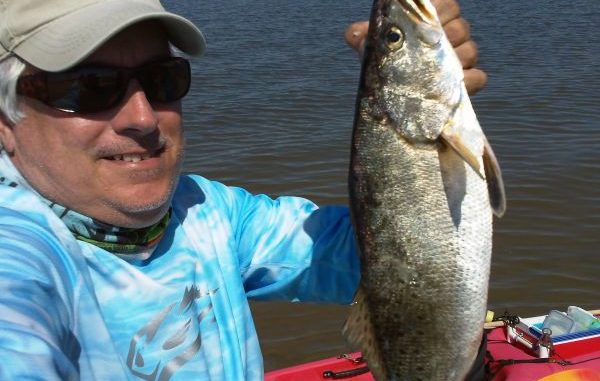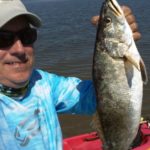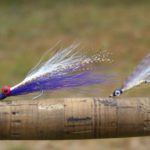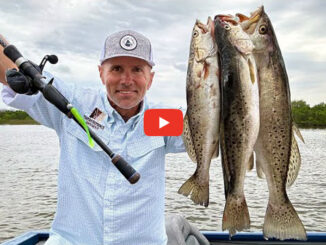
The Louisiana Outdoor Writers Association maintains the state fish records for each species, both for conventional tackle and fly tackle. And one glance at the fly-rod listings for speckled trout suggests that winter through early spring is the best time to catch trophy trout on a fly.
The weights range from two 6.75-pounders — one by Mark Wentz in Calcasieu Lake and one by Dave Coignet in Catfish Lake — up to 9.31 pounds taken by Jeff Poe at Calcasieu Lake.
What the listings don’t show are the flies used to catch those snaggle-toothed beasts.
Having kept my finger on the pulse of all things fly fishing in Louisiana, I can say that most flies used to catch big winter trout — from 3-pounders on up — have been baitfish patterns in either neutral or dark colors.
Now, I know what you’re thinking because I’m partially psychic. I actually got two of the six numbers correct in last month’s Powerball Lottery.
You’re thinking, “What about Cormier’s Fifth Law?”
Cormier’s Fifth Law of Fly Fishing states that “any color is good for speckled trout, as long as it’s chartreuse.”
However, there’s a corollary to that law that states that “purple is a shade of chartreuse.”
So why does purple outperform chartreuse in colder water?
First off, one reason chartreuse works so well most of the year is because of aquatic bioluminescence. Algae in saltwater respond to the movement of fish, shrimp and other organisms by emitting light, often close to chartreuse in color. Predators key in on this.
Cold water holds less sediment and less organics. So bioluminescence is generally absent, and visibility is much greater. Trout can readily identify their prey by sight. Matching the hatch becomes more critical — not just in shape or form, but also in color.
Take a look at a cocahoe minnow, aka Gulf killifish, in winter. The area from above the operculum to the dorsal spine often has a purple tone.
In addition, the male cocahoe often has glittering spots of gold scales extending above and below the lateral line.
That’s why when winter arrives speckled trout of all sizes become huge LSU fans. They might not bleed purple and gold, but they’ll eat purple and gold.
Two specific patterns with which I’ve had excellent results are the LSU Clouser and the LSU Flasher, both of which mimic late-season minnows.
The LSU Clouser is a color variation of Bob Clouser’s famous minnow pattern. Tied on a saltwater hook (Mustad S71-34007 or equivalent), the tail is white or yellow bucktail and the wing is purple bucktail. In between the wing and tail are strands of gold krystal flash, typically eight to 12 strands.
Depending on whether I’m fishing deep (using an intermediate or sink-tip fly line) or shallow (floating line), the size of the dumbbell eyes vary from 1/60 ounce to 1/32 ounce.
When fishing deep dead-end canals, pits, tidal holes or cuts, I cast the LSU Clouser and let it sink to the bottom. Then I make small strips back up.
Trout can be on the bottom or suspended a couple feet above. Either way, I’ve got it covered.
On sunny winter afternoons, trout move up to shallow flats to feed. This is when I switch to a rod with a floating line and an LSU Clouser suspended about 3 feet under a VOSI.
The LSU Flasher is a color variation of Tom Broderidge’s unconventional Flasher Fly. Broderidge, a resident of Havana, Florida, wrote the first book on fly fishing the Gulf Coast, appropriately titled “Fly Fishing the Gulf Coast.”
The Flasher has a gold braid body and a two-tone wing of bucktail or ultra hair. What makes it unconventional is a small spinner blade attached at the bend of the hook using a monofilament loop.
One modification I’ve made to the original version of this fly is to add stick-on eyes, which I then protect with small dabs of clear epoxy. I believe predatory fish key on eyes, especially in clear water.
When retrieving the LSU Flasher, I use fast, small strips that allow the blade to rotate freely and away from the hook. However, a friend has caught a variety of species — mostly bass — by stripping in a Flasher and letting it flutter down for a few seconds.
Try both techniques and see which one works best.
No matter what fly you use, keep in mind that trout feed very slowly when the water is cold. As my buddy Morris Houck likes to say: If you think you’re fishing a lure or fly slowly, it’s still probably too fast.
One more piece of advise: If you do catch a monster speck, keep it only if you plan to submit it to the records. Otherwise, turn it loose and keep the smaller fish — 4 pounds or lighter.
Let those beasts breed more beasts.




